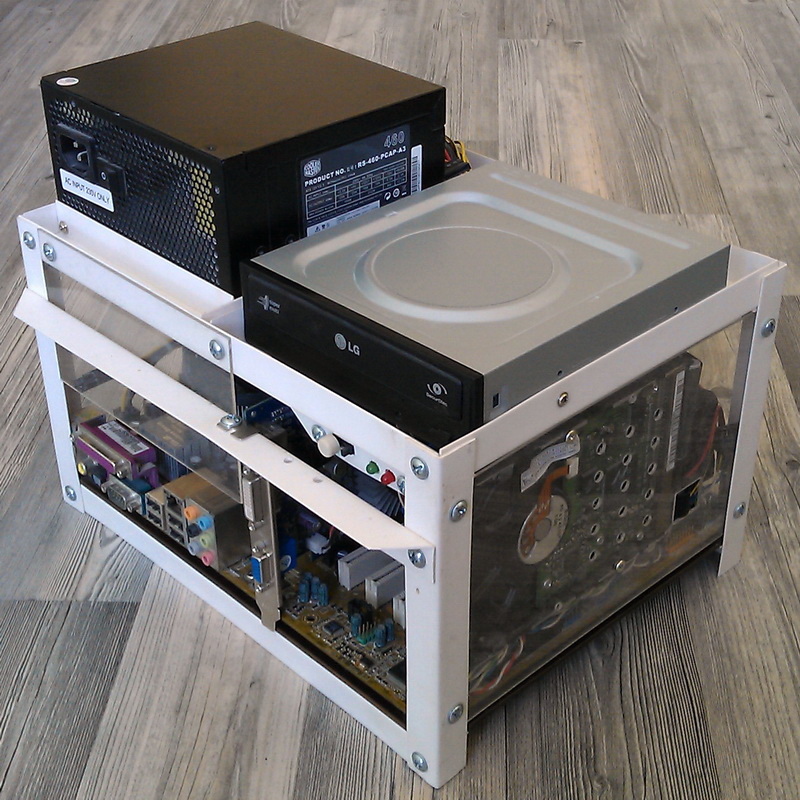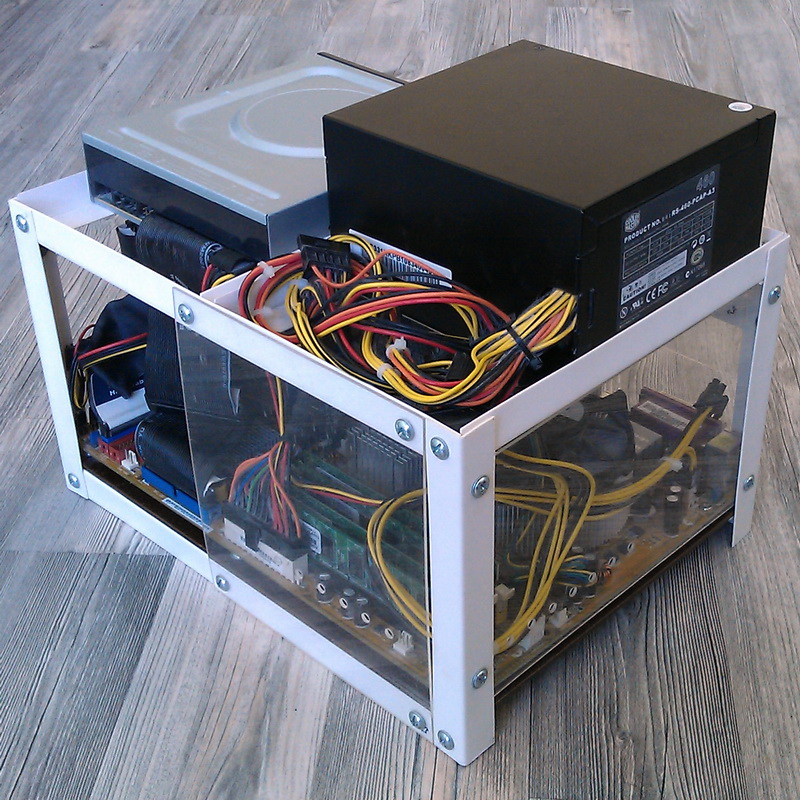How to increase the mobility of the home desktop or “do not part with your loved ones”
 Greetings to all the Habrazhitel!
Greetings to all the Habrazhitel! I want to share the story of the creation of one "crafts". Perhaps my experience will be useful to people who occasionally have to travel “without comfort” and who do not want to part with their favorite home desktop.
At the dawn of my youth I had the chance to fly on business trips to one or two months to one hot African country. The frequency of such trips is once or twice a year. The work was closely connected with the use of the computer, and the place of work was the cabin on the ship, which during this period was anchored a few miles from the shore (scheduled inter-cruise maintenance). The employer company provided laptops for such trips, which, although they were only slightly more productive than ordinary bricks, generally coped with their task (mainly it was work with spreadsheets). But on long African evenings in my spare time from work, I wanted something for the soul - at least watch a movie before going to bed or run into a shooter. And in my case, the soul additionally required to work on site building under a bunch of apache + php + mysql, to study Maya, to write a couple of programs ... And much more of this required, to which the equipment entrusted to me was not at all adapted. Yes, and working issues would be resolved faster and more pleasant ...
Before the second such trip, I seriously thought about how to improve the quality of computer life on the ship. The idea of acquiring a laptop was not considered, since then (by the way, it was somewhere in 2004) it was tense for me financially. Yes, and changing the desktop to a laptop for one trip in a year was not advisable for obvious reasons - a desktop with the same characteristics is cheaper, easier to upgrade and more convenient (IMHO) for home use.
It was decided to bring a home desktop with you! To understand the extent of the problem, I will describe the route: two hours by bus, nine hours by plane, another bus to the pier, transfer to some transport vessel, about an hour of talk on an open deck, then climb a narrow ladder aboard the target ship, towering above the deck of the transporter to a height of about 5 meters. With itself, among other things - a bag with clothes and household accessories per month cut off from civilization life. It is clear that it’s unrealistic to drag a system unit and a monitor (and I also had a CRT monitor!) Everything should fit in a maximum of two bags, and all the delicate electronics must be carried into the plane like hand luggage, since the cargo personnel of the airports are not particularly accurate,
The monitor, of course, definitely had to be exchanged for a liquid crystal display, since such an upgrade was long overdue and planned. A 17-inch monitor wrapped in thin foam and tucked away in a makeshift cardboard box fits perfectly in a suitably sized bag. All the stuffing of the system, except for the power supply and the CD-ROM drive, fit in a box from the motherboard (board, processor + cooler, memory, video card and a HDD dear to my heart, carefully checked and sealed by customs authorities in connection with the export of intellectual property abroad: )). This box went into the bag to the monitor. The power supply unit, CD-ROM and a removable monitor stand were recognized as not related to “thin electronics” - they were wrapped in different towels and sweaters and packed in a second bag, which was intended for handing in luggage.
As a result, the bag with the code name “hand luggage” fit all of the above, plus a slim keyboard, mouse, passport ... and the place ran out.
The key problem that this post is dedicated to is how to put it all together at the destination, so that the month will work and not break. This task has undergone a number of metamorphoses:
Idea 1: to assemble on the knee (aka “ nail to the wall ”, etc.) - should work, but it will be extremely unreliable in conditions of sea rolling, terribly inconvenient in a limited space and generally illiterate. The idea is discarded right away.
Idea 2: buy a small system unit. Nothing suitable that would not exceed (or slightly exceed) the size of the box from the motherboard in the access area was not found (especially taking into account the discrete video card).
Idea 3: to adapt the notorious box from the motherboard as a kind of frame for the motherboard and video card by cutting different technological holes in it. At the same time, the power supply and CD-ROM hang separately. After a long and thoughtful look at the box, it became clear that the option is almost no different from point 1 - it does not fit.
Idea 4 - Do It Yourself. At this stage, the idea has finally matured that the framework for electronic filling must be developed independently, taking into account all the described nuances. After a short experiment, a design was born that surprisingly performed well in subsequent combat trials. It has sufficient rigidity, lightness, relative ease of assembly / disassembly. Moreover, even to some extent, the ventilation scheme of the entire system as a whole has been preserved.



The basis of the design is a textolite rectangle exactly the size of the motherboard (ATX 12 "x 9" (30.5 cm x 23 cm)). The board is attached to it through special adapters that are used to mount the boards in many ordinary system devices - in fact, it is a screw with an extended hex head, in which there is a thread for the screw that secures the board itself (lying around in bulk in almost all computer stores). The rest of the frame is assembled from pieces of a plastic corner with a side of 20 mm (purchased at the nearest hardware store) and pieces of thin (1.5 mm) transparent plexiglass. Everything is fastened together by short screws with a wide head and nuts. I think from the photo you can easily understand the whole uncomplicated essence of the design. A separate section of the corner is used to attach expansion cards. The hard drive is screwed to one of the transparent walls, where the holes are made to ventilate his electronics. The power supply and CD-ROM are also attached to the frame with regular screws. Power / restart buttons and LED indicators are mounted in a short section of the corner.
Assembly / disassembly took no more than 10 minutes in the presence of experience. In the disassembled state, everything fits in the same box from the motherboard (textolite and plexiglass - for the board; the corners enclosed in each other also do not take up much space, plus a bag with fasteners).
Of the minuses of the design, a complete lack of shielding can be noted, but in the case of the iron steamer, the walls of the cabin perfectly served as screens, and there was no other electronics within it. Also, some sections of the board remained in relatively free access, which is not very good from the point of view of its security, but there were no unpleasant incidents.
Here is another photograph taken in "combat conditions":

As a result, the passion for knowledge is satisfied, months away from home were not in vain. After the next upgrade, this design became the case for the second home computer (from old components) and still serves faithfully. There was even an attempt to install a modern monstrous video card in two slots thickness in this case - it was generally successful, but for the convenience of connecting additional power to the video card, you need to slightly increase the height of the structure, plus the card’s “tail” stands for dimensions.
Upd.In connection with the large number of comments about the advantage of laptops and other ready-made mobile solutions, I want to emphasize again: 2004, laptops are not as accessible as they are now, I was yesterday “poor student”, and I was not at all pleased with the thought for the sake of one relocation in a year invested in a laptop with parameters close to the already available desktop. Obviously, a laptop, with their current availability, will be the best solution for those who have to travel a lot. The option described in the article may be more suitable for those who need to work temporarily away from home, and the conditions for the transportation of bulky goods are limited.
